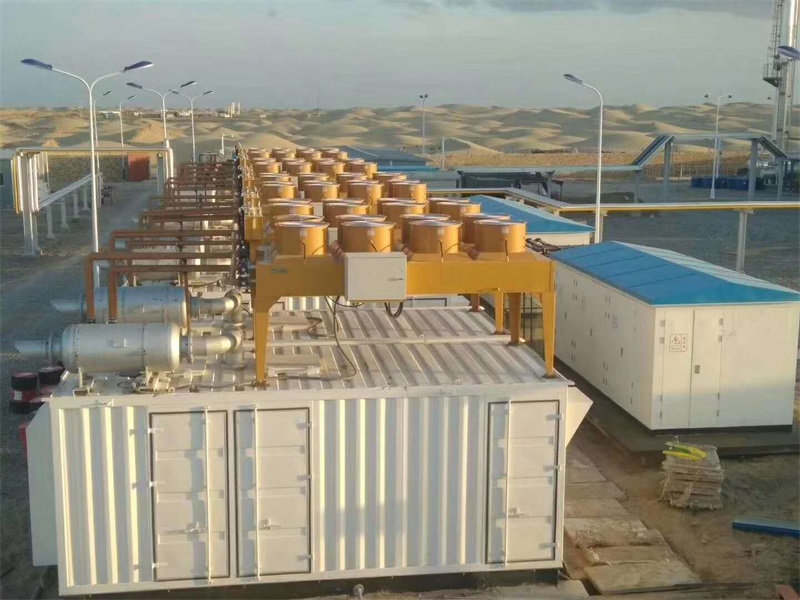瓦斯發(fā)電機組余熱回收的主要用途
對于瓦斯發(fā)電機組,瓦斯產(chǎn)生的能量只有30%—35%被轉(zhuǎn)化為電能,約有30%—35%隨高溫尾氣排出,約20%—25%被發(fā)動機自身冷卻系統(tǒng)帶走,約10%以機身散熱和阻力等其他損耗。瓦斯發(fā)電機組余熱利用就是通過專用設備將機組排出的高溫尾氣和冷卻系統(tǒng)帶走的熱量回收,再輸送到需要熱源的車間或居民小區(qū)。

For gas generator sets, only 30% - 35% of the energy generated by gas is converted into electric energy, about 30% - 35% is discharged with high-temperature tail gas, about 20% - 25% is taken away by the engine's own cooling system, and about 10% is consumed by other losses such as body heat dissipation and resistance. The waste heat utilization of gas generator unit is to recover the high-temperature tail gas discharged by the unit and the heat taken away by the cooling system through special equipment, and then transport it to the workshop or residential area requiring heat source.
余熱回收的方式根據(jù)各個企業(yè)所需要的熱源不同有空氣置換余熱、軟化水置換余熱產(chǎn)生熱水以及軟化水置換余熱產(chǎn)生蒸汽三種。余熱回收后的主要用途有以下幾種:
According to the different heat sources required by each enterprise, there are three ways of waste heat recovery: air replacing waste heat, demineralized water replacing waste heat to produce hot water and demineralized water replacing waste heat to produce steam. The main uses of waste heat recovery are as follows:

(1)煤礦巷道暖井(風井供熱風):在北方的冬季,煤礦風井巷道都需要熱風爐暖井。把低濃度瓦斯發(fā)電機組產(chǎn)生的高溫尾氣經(jīng)過熱管空預器,將冷空氣加熱,可以得到高溫熱風通過煙道與風井處得熱管空預器再次換熱后的熱空氣送入風井,從而降低井下熱風爐的熱量輸出,節(jié)約電能。
(1) Coal mine roadway warm-up shaft (air shaft heating air): in northern winter, coal mine air shaft roadway needs hot-air stove warm-up shaft. The high-temperature tail gas generated by the low concentration gas generator unit passes through the heat pipe air preheater and heats the cold air. The high-temperature hot air can be obtained. The hot air after heat exchange through the heat pipe air preheater at the flue and air shaft is sent to the air shaft, so as to reduce the heat output of the underground hot blast stove and save electric energy.
(2)烘干、采暖和洗浴用熱源:
(2) Heat source for drying, heating and bathing:
企業(yè)生產(chǎn)工藝中的烘干、采暖和洗浴常年需要熱源。在發(fā)電機組煙道出口加裝一臺熱管換熱器(熱管省煤器),通過熱水循環(huán)泵幾個低溫水送到熱管換熱器,經(jīng)過熱交換的軟化水為熱源(90℃以上)供給企業(yè)生產(chǎn)使用,冷卻后的軟化水在返回熱管換熱器,如此往復循環(huán)。
The drying, heating and bathing in the production process of the enterprise need heat source all the year round. A heat pipe heat exchanger (heat pipe economizer) is installed at the flue outlet of the generator set, and several low-temperature water is sent to the heat pipe heat exchanger through the hot water circulating pump. The softened water after heat exchange is supplied to the enterprise for production and use as a heat source (above 90 ℃), and the cooled softened water is returned to the heat pipe heat exchanger for reciprocating circulation.
(3)余熱制冷:目前廣泛采用溴化鋰吸收式制冷。用熱管蒸發(fā)器吸收低濃度瓦斯發(fā)電機組余熱回收的熱量。
(3) Waste heat refrigeration: lithium bromide absorption refrigeration is widely used at present. Heat pipe evaporator is used to absorb the heat recovered from waste heat of low concentration gas generator set.
(4)余熱發(fā)電:通過多臺瓦斯發(fā)電機組尾氣的余熱回收,安裝熱管蒸發(fā)器,產(chǎn)生的飽和蒸汽并往后拖動汽輪機組進行二次發(fā)電,發(fā)電后的冷凝水亦可制冷或者供暖,給企業(yè)帶來可觀的經(jīng)濟效益。
(4) Waste heat power generation: through the waste heat recovery of tail gas of multiple gas generator units, install heat pipe evaporator, generate saturated steam and drag the steam turbine unit back for secondary power generation. The condensate after power generation can also be cooled or heated, bringing considerable economic benefits to the enterprise.
 在線咨詢
在線咨詢 官方二維碼
官方二維碼




 當前位置:
當前位置: 2021.08.11
2021.08.11









